Interview: Photographer Wolfgang Tillmans | reviews, news & interviews
Interview: Photographer Wolfgang Tillmans
Interview: Photographer Wolfgang Tillmans
Surprising collisions of light and time in the work of a unique photographer
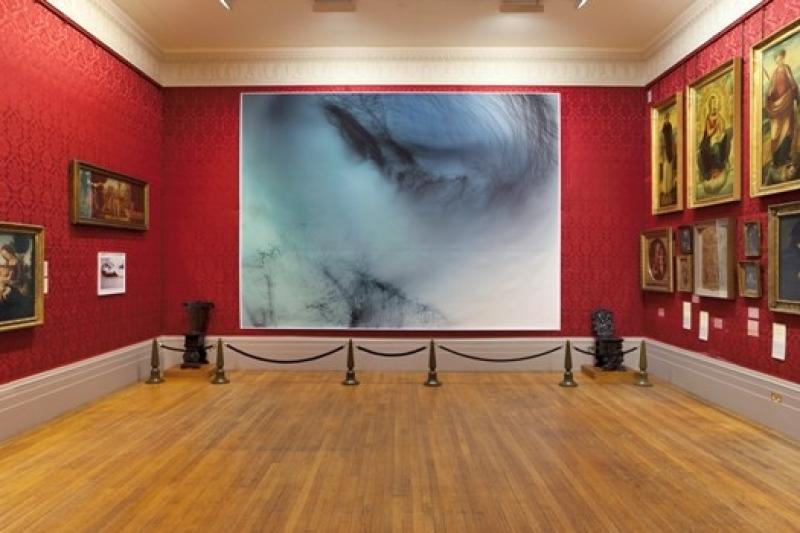
The 2010 Brighton Photo Biennial has seen unprecedented numbers of visitors flock to the coast, and tonight will host a talk by one of the most original fine-art photographers working in Britain today.
It’s easier to imagine a Tillmans show in the city’s Docklands Culture Quarter where glass and steel have replaced the Walker’s stone and marble and Tate Liverpool is the hub for international contemporary art. But the visionary decision of the Gallery, the Arts Council Collection and especially Tillmans, has resulted in a brilliant and unpredictable transformation which will doubtless be imitated often.
After living for 20 years in London (and in 2000 he won the Turner Prize), he has developed a highly personal visual identity as a photographer and almost equally significantly as a curator. When invited to work with the permanent collection at the Walker, he chose nine pieces owned by the Arts Council Collection, and three lent from his private collection, and set about inserting them respectfully, ironically, even amusingly, amongst portraits, landscapes, still-lifes and abstracts spanning almost four centuries.
Like many other 19th-century northern galleries, the Walker largely follows the traditional curation formula of crowding paintings together on richly coloured, fabric-clad walls. And with such large collections, it is obviously the way to exhibit the maximum stock. That approach is the antithesis of Tillmans’ minimalist and seemingly random but carefully planned displays against white walls. He didn’t request a white-out but still undoubtedly leaves many loyal gallery visitors frowning and tutting at the challenging sight of contemporary conceptual works lodging like cuckoos amongst their favourites. Yet in almost every case, it works brilliantly. Ann Bukantas, Head of Fine Art at the Walker, says, “The installation functions like a work of art in its own right.”
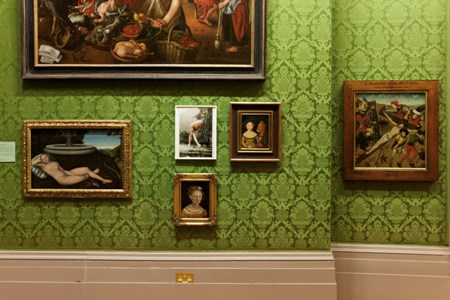 With great courage, Bukantas and the Arts Council Collection directors offered Tillmans freedom to shift works from their familiar resting places or to remove them altogether. In advance of his first visit, he studied the permanent collection through old catalogues and then marched in partly aware of some ideas for "an intervention". It’s an appropriate term because his Modernist portraits and seemingly mundane scenes do intervene, wedged between familiar 18th and 19th centuries and including Impressionists, to create an entirely new design for the rooms and contextual meanings for both parties (Dan, 2008, pictured above).
With great courage, Bukantas and the Arts Council Collection directors offered Tillmans freedom to shift works from their familiar resting places or to remove them altogether. In advance of his first visit, he studied the permanent collection through old catalogues and then marched in partly aware of some ideas for "an intervention". It’s an appropriate term because his Modernist portraits and seemingly mundane scenes do intervene, wedged between familiar 18th and 19th centuries and including Impressionists, to create an entirely new design for the rooms and contextual meanings for both parties (Dan, 2008, pictured above).
A typical Tillmans exhibition is self-curated and meticulously designed with careful placing and spacing and the all-important flow. Isolated single images, well-spaced clusters of related pieces arranged in careful patterns, cheap prints pinned or stuck to walls, and exquisitely framed images hung like the most priceless portraits in the Walker gallery, all add up to his curatorial identify. Here, he had just 12 photographs to "play" with.
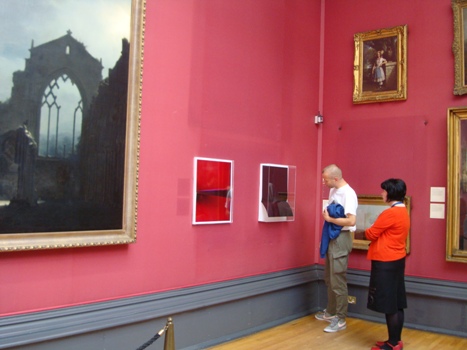 When I arrived in the gallery where Tillmans was involved in hanging two works, he was standing facing the radiant orange glow of a Turner sunset and the gothic gloom of an oil painting by Louis Daguerre entitled The Ruins of Hollyrood Chapel, c 1824 (pictured left). He was holding two small, square, glossy pieces of photographic paper from his Lighter series (Lighter, red II and Lighter, AC3), part of a mathematically arranged installation at the Serpentine Gallery. Here, he was focussing on the Frenchman: “He was a painter first and about 15 years later, he invented photography through the daguerrotypes. The Turner is also about light - and about abstraction, but he wouldn’t have known that as a concept then. Next to those, I will put these two other studies of light, photographs that are completely refusing to represent anything like the role of photography for those last 150 years, that has always been to represent, document, show something else other than itself. And these resolutely answer back, "I’m not showing you anything"."
When I arrived in the gallery where Tillmans was involved in hanging two works, he was standing facing the radiant orange glow of a Turner sunset and the gothic gloom of an oil painting by Louis Daguerre entitled The Ruins of Hollyrood Chapel, c 1824 (pictured left). He was holding two small, square, glossy pieces of photographic paper from his Lighter series (Lighter, red II and Lighter, AC3), part of a mathematically arranged installation at the Serpentine Gallery. Here, he was focussing on the Frenchman: “He was a painter first and about 15 years later, he invented photography through the daguerrotypes. The Turner is also about light - and about abstraction, but he wouldn’t have known that as a concept then. Next to those, I will put these two other studies of light, photographs that are completely refusing to represent anything like the role of photography for those last 150 years, that has always been to represent, document, show something else other than itself. And these resolutely answer back, "I’m not showing you anything"."
This seems to be a favourite corner, “a nice bracket of experimentation with the exploration of light and how to represent it”, he smiles. "The Lighters are made by blasting photosensitive paper with light so that it goes black. It’s completely an analogue process,” he stresses. Before hanging them, he stares at the wide, empty expanse of red fabric and the faded Rothko-esque rectangles representing previous occupants. He confides that he would love to leave it blank, as he would usually, a suggestion of Rothko’s explorations of light. He doesn’t.
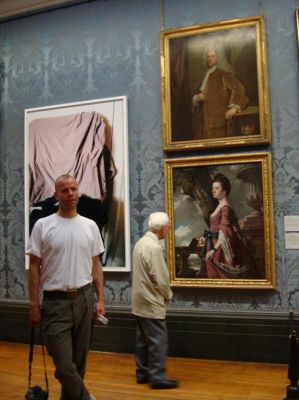 Of course, some regulars who visit their favourite paintings will find these switches unsettling. But it’s temporary, Tillmans reminds me as we move into a gallery lined with portraits of the 18th and 19th century’s land-owning aristocracy. A gorgeous Gainsborough portrait of a lady had already been uprooted and moved. “I carefully asked if that could be maybe moved and they said it has to stay on show because it is one of the masterpieces in the collection. But they figured out that it could go here.” The substitute was Tillmans’ beautifully toned, incongruously scruffy image amongst the exhibitionism of wealth and glamour. His dusty-pink crumpled T-shirt and pair of jeans lying on a floor hang next to a portrait by Joseph Wright of Derby, the elegant Mrs Frances Hesketh, in a silk dress whose smoky-pink tone precisely matches the T-shirt’s (pictured right: Wolfgang Tillmans and a passing art lover). Sheer chance, he says, and a link which delights him. We study the painter’s textural achievement and his direction and control of reflective highlighting of the silky folds. He seems to almost envy the luminosity achievable with oils. “I’ve always looked at the Gainsboroughs and Reynolds really only for the drapery,” he confesses. “They seemed to have got much more off on the display of how to treat the fabrics, and faltenwalf, the German term for drapery (and the title of this piece), has also been running through my work for 20 years. I think it works for [the painters] because they observed very carefully.”
Of course, some regulars who visit their favourite paintings will find these switches unsettling. But it’s temporary, Tillmans reminds me as we move into a gallery lined with portraits of the 18th and 19th century’s land-owning aristocracy. A gorgeous Gainsborough portrait of a lady had already been uprooted and moved. “I carefully asked if that could be maybe moved and they said it has to stay on show because it is one of the masterpieces in the collection. But they figured out that it could go here.” The substitute was Tillmans’ beautifully toned, incongruously scruffy image amongst the exhibitionism of wealth and glamour. His dusty-pink crumpled T-shirt and pair of jeans lying on a floor hang next to a portrait by Joseph Wright of Derby, the elegant Mrs Frances Hesketh, in a silk dress whose smoky-pink tone precisely matches the T-shirt’s (pictured right: Wolfgang Tillmans and a passing art lover). Sheer chance, he says, and a link which delights him. We study the painter’s textural achievement and his direction and control of reflective highlighting of the silky folds. He seems to almost envy the luminosity achievable with oils. “I’ve always looked at the Gainsboroughs and Reynolds really only for the drapery,” he confesses. “They seemed to have got much more off on the display of how to treat the fabrics, and faltenwalf, the German term for drapery (and the title of this piece), has also been running through my work for 20 years. I think it works for [the painters] because they observed very carefully.”
We move to a hushed and densely packed room featuring religious scenes and biblical narratives and encounter the most breathtaking installation in the collection. The end wall is filled with one of Tillmans’ greatest, most sublime – and technically confusing - works, Freischwimmer (main picture, above). With its liquid effect and abstract swirls and rhythms, it comes closest to total abstraction, and to painting rather than photography, and it replaces a vast 500-year-old Flemish tapestry now in storage. The most audacious intervention, it transforms the atmosphere in the room; Tillmans notices how the blue tones of the very different skies are all now similarly highlighted.
For a complete change, we visited the John Moores permanent collection which was launched with Pop Art, and find the gallery stripped empty of all but a Patrick Caulfield and a Michael Craig Martin painting. Here, Tillmans adds a perfectly appropriate, perfectly mundane and scruffy scene focusing on two upturned transparent blue plastic chairs. Their transparency chimes across the room with Caulfield’s typically skeletal, 3-dimensional representation in a harmonious pairing which lacks the ripples created elsewhere in the show.
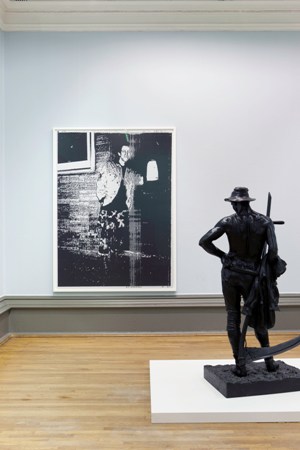 And similarly, in a small intimate room used to accommodating Romantic portrait painters including Degas, he makes a dramatic stage-set-like installation by introducing a life-sized, blackened bronze statue of a farmhand. The Mower, 1894 by William Hamo Thornycroft (pictured left) stands facing a tall photograph titled Empire (Punk), 2005 and possessing an interesting history. It was faxed to Tillmans in the early Nineties, converted to a Xerox copy and recently scanned at “super-high resolution” and printed onto photographic paper. The effect close-to is of such magnification as to suggest a textured geological lunar surface, but further away focuses as a life-sized young man lolling against a wall in Doc Martens. The Mower's pose, with hand on hip and bent knee and his scythe casually slung over one shoulder, today interprets as a gay come-on. “Yes,” the photographer laughs. “There is a slight queer subtext! I think they will possibly leave him here.”
And similarly, in a small intimate room used to accommodating Romantic portrait painters including Degas, he makes a dramatic stage-set-like installation by introducing a life-sized, blackened bronze statue of a farmhand. The Mower, 1894 by William Hamo Thornycroft (pictured left) stands facing a tall photograph titled Empire (Punk), 2005 and possessing an interesting history. It was faxed to Tillmans in the early Nineties, converted to a Xerox copy and recently scanned at “super-high resolution” and printed onto photographic paper. The effect close-to is of such magnification as to suggest a textured geological lunar surface, but further away focuses as a life-sized young man lolling against a wall in Doc Martens. The Mower's pose, with hand on hip and bent knee and his scythe casually slung over one shoulder, today interprets as a gay come-on. “Yes,” the photographer laughs. “There is a slight queer subtext! I think they will possibly leave him here.”
The significance of this dual encounter between the two men spanning a century, reaches beyond gay iconography and into class issues; Tillmans points out that this was one of the first sculptures in European art to depict a worldly, working-class subject. "I’m interested in that time of naturalism and the shift of emphasis away from church and class," he explains. "The Degas portrait of a girl sitting again fits the mood [of the room].”
As I left the gallery inspired, refreshed and whirling with thoughts to process on the train, I turned to Caroline Douglas, Head of the Arts Council Collection, for a broader view: “I see its significance as demonstrating that art is a continuum across centuries, a conversation that goes on beyond generations and one that we are all a part of.”
Share this article
The future of Arts Journalism
You can stop theartsdesk.com closing!
We urgently need financing to survive. Our fundraising drive has thus far raised £49,000 but we need to reach £100,000 or we will be forced to close. Please contribute here: https://gofund.me/c3f6033d
And if you can forward this information to anyone who might assist, we’d be grateful.

Subscribe to theartsdesk.com
Thank you for continuing to read our work on theartsdesk.com. For unlimited access to every article in its entirety, including our archive of more than 15,000 pieces, we're asking for £5 per month or £40 per year. We feel it's a very good deal, and hope you do too.
To take a subscription now simply click here.
And if you're looking for that extra gift for a friend or family member, why not treat them to a theartsdesk.com gift subscription?
more Visual arts
 'We are bowled over!' Thank you for your messages of love and support
Much-appreciated words of commendation from readers and the cultural community
'We are bowled over!' Thank you for your messages of love and support
Much-appreciated words of commendation from readers and the cultural community
 Folkestone Triennial 2025 - landscape, seascape, art lovers' escape
Locally rooted festival brings home many but not all global concerns
Folkestone Triennial 2025 - landscape, seascape, art lovers' escape
Locally rooted festival brings home many but not all global concerns
 Sir Brian Clarke (1953-2025) - a personal tribute
Remembering an artist with a gift for the transcendent
Sir Brian Clarke (1953-2025) - a personal tribute
Remembering an artist with a gift for the transcendent
 Emily Kam Kngwarray, Tate Modern review - glimpses of another world
Pictures that are an affirmation of belonging
Emily Kam Kngwarray, Tate Modern review - glimpses of another world
Pictures that are an affirmation of belonging
 Kiefer / Van Gogh, Royal Academy review - a pairing of opposites
Small scale intensity meets large scale melodrama
Kiefer / Van Gogh, Royal Academy review - a pairing of opposites
Small scale intensity meets large scale melodrama
 Jenny Saville: The Anatomy of Painting, National Portrait Gallery review - a protégé losing her way
A brilliant painter in search of a worthwhile subject
Jenny Saville: The Anatomy of Painting, National Portrait Gallery review - a protégé losing her way
A brilliant painter in search of a worthwhile subject
 Abstract Erotic, Courtauld Gallery review - sculpture that is sensuous, funny and subversive
Testing the boundaries of good taste, and winning
Abstract Erotic, Courtauld Gallery review - sculpture that is sensuous, funny and subversive
Testing the boundaries of good taste, and winning
 Edward Burra, Tate Britain review - watercolour made mainstream
Social satire with a nasty bite
Edward Burra, Tate Britain review - watercolour made mainstream
Social satire with a nasty bite
 Ithell Colquhoun, Tate Britain review - revelations of a weird and wonderful world
Emanations from the unconscious
Ithell Colquhoun, Tate Britain review - revelations of a weird and wonderful world
Emanations from the unconscious
 Rachel Jones: Gated Canyons, Dulwich Picture Gallery review - teeth with a real bite
Mouths have never looked so good
Rachel Jones: Gated Canyons, Dulwich Picture Gallery review - teeth with a real bite
Mouths have never looked so good
 Yoshitomo Nara, Hayward Gallery review - sickeningly cute kids
How to make millions out of kitsch
Yoshitomo Nara, Hayward Gallery review - sickeningly cute kids
How to make millions out of kitsch
 Hamad Butt: Apprehensions, Whitechapel Gallery review - cool, calm and potentially lethal
The YBA who didn’t have time to become a household name
Hamad Butt: Apprehensions, Whitechapel Gallery review - cool, calm and potentially lethal
The YBA who didn’t have time to become a household name

Add comment